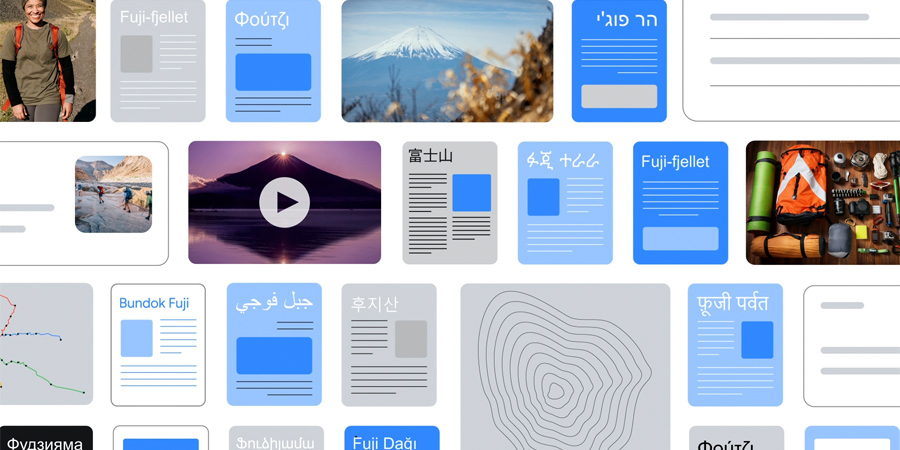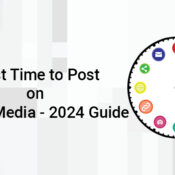09/23/2021
/
Google MUM Update – Difference between MUM and BERT
Google is becoming more pragmatic for users and is constantly updating to improve user experience. New Google algorithms and updates are rolled out regularly, and this time it's Google MUM update.
Remember BERT? MUM is similar to BERT and aims at overcoming language and format barriers for an intuitive and inclusive search. That said, whenever Google brings in updates for users, the competition crops up between website owners, businesses, advertisers and agencies to gain more search visibility.
Let’s see how MUM favors them, along with the difference between MUM and BERT.
Picture this- You’ve been to India. Now you want to visit America next year, but it’s your first experience. Now, you ask Google to help you with this, you will search for weather, places to visit, things to consider, and other such thoughtful searches. And after doing this, you will be able to pile up a directory of all the things that you should remember on your to the US.
Sounds Complex? It is complex, absolutely.
Take another scenario, where you go to a travel expert or guide and ask them about how and what to do to make a happy trip to the US. Surely, he will guide you with all your queries without much ado. Not only this, he will guide you with other nuances that you might be missing. But for Google, the operation is quite complex, and it deals with 10-15 such search queries in a day. As the age is racing towards AI, so is Google trying to improvise its searches using AI, and this becomes the launching pad for Google MUM, Multitask Unified Model. The model will facilitate complex searches in the future for a smooth user experience.

 Putting it simply, MUM is meant to do away with the complexities and barriers of language to respond to user queries in a comprehensive and user-friendly way. The results are sweeping and are more sophisticated than any previous version, and meet the users’ expectations for instant, detailed and relevant answers. It collects insight from multiple sources on related search aspects to generate a comprehensive answer. While expanding search dimensions, it views user queries from a different perspective to compare and extract answers that users are seeking.
SEO has been an important aspect of search results and will surely see the upshot drawn on the basis of what information is asked for, serves the purpose and matches search intent. Keywords that are phrase-friendly or are used in a more natural context are more likely to reign. Formats other than text, images, video and audio, will be used in the future to solve user queries.
Though language is still the key, the content will matter a lot. More specific and relevant answers will get a website among their competitors.
After Google MUM Update, understanding the difference between MUM and BERT will not only let you structurally implement both but would also benefit users to get AI-based advanced solutions.
Putting it simply, MUM is meant to do away with the complexities and barriers of language to respond to user queries in a comprehensive and user-friendly way. The results are sweeping and are more sophisticated than any previous version, and meet the users’ expectations for instant, detailed and relevant answers. It collects insight from multiple sources on related search aspects to generate a comprehensive answer. While expanding search dimensions, it views user queries from a different perspective to compare and extract answers that users are seeking.
SEO has been an important aspect of search results and will surely see the upshot drawn on the basis of what information is asked for, serves the purpose and matches search intent. Keywords that are phrase-friendly or are used in a more natural context are more likely to reign. Formats other than text, images, video and audio, will be used in the future to solve user queries.
Though language is still the key, the content will matter a lot. More specific and relevant answers will get a website among their competitors.
After Google MUM Update, understanding the difference between MUM and BERT will not only let you structurally implement both but would also benefit users to get AI-based advanced solutions.
 Everyone can answer what is being asked, but with MUM, the question is not answer what is not being asked but is intended. Users, businesses, and content creators have to read between the lines to create tangential content. Exact responses will not be your saviours; take a dive into the general, layered and complex user queries and intent to create your content. Powered by AI, it’s going to be a breakthrough process. Now that we have seen the difference between MUM and BERT, we know that both works using AI and entails sophistication on language grounds.
For ex. How to reach a country will not be supported by the answer take this flight or that flight; you have to talk more comprehensively- where to get on, get off, hotels, area, visas, vaccination, weather, etc. List it all to provide value to your clients through your content.
Everyone can answer what is being asked, but with MUM, the question is not answer what is not being asked but is intended. Users, businesses, and content creators have to read between the lines to create tangential content. Exact responses will not be your saviours; take a dive into the general, layered and complex user queries and intent to create your content. Powered by AI, it’s going to be a breakthrough process. Now that we have seen the difference between MUM and BERT, we know that both works using AI and entails sophistication on language grounds.
For ex. How to reach a country will not be supported by the answer take this flight or that flight; you have to talk more comprehensively- where to get on, get off, hotels, area, visas, vaccination, weather, etc. List it all to provide value to your clients through your content.
 With an improved understanding of the reading text, just like humans, Google is improvising at a revolutionary pace. Now, to upkeep with this pace, businesses and advertisers must adopt this new language model and restructure their overall course.
With an improved understanding of the reading text, just like humans, Google is improvising at a revolutionary pace. Now, to upkeep with this pace, businesses and advertisers must adopt this new language model and restructure their overall course.
MUM in Nutshell
Today, Google users face troubles with multiple interrelated-searches and language and geographical barriers. To tackle this, Google implemented an AI-powered algorithm to meet the demand of modern users and their searches and improve search results. The update has empowered Google to understand 75 different languages to answer complex and comprehensive queries. MUM will reduce the number of search queries and provide an acceptable response to users with fewer searches. Fewer Searches=Inclusive Results MUM, being a multi-model, is trained to understand search queries not only through textual content but also through analyzing the images, videos, audios and other futuristic modalities in a refined way to fetch solutions. It is about to change the way people search on Google. Google says, “MUM not only understands language but also generates it. It’s trained across 75 different languages and many different tasks at once, allowing it to develop a more comprehensive understanding of information and world knowledge than previous models. And MUM is multimodal, so it understands information across text and images and in the future, can expand to more modalities like video and audio. Google MUM is built on the transformer architecture and T5 framework, just like other language models BERT, LaMDA and GPT-3. Transformer architecture is a novel neural network model that adopts an encoder and decoder architecture and transforms one sequence into another one with the help of two parts (Encoder and Decoder). It improves text-to-speech, speech recognition and other sequence-to-sequence tasks.Comparison between BERT and MUM

BERT preceded MUM
The transformer system used for MUM is the same as BERT, a powerful language model that made strides in 2019. BERT or Bidirectional Encoder Representations from Transformers is a transformer-based machine learning model for natural language processing (NLP) pre-training. BERT helps search engines learn contextual relations between words and decode ambiguous text based on previous search queries to increase the understanding of human language. Using BERT, search engines can understand the context of the word to know the user search intent. It reads the text from both left and right for a contextual understanding of words. If you search for "Define BERT", you will get a proposed definition only, but if you search for “What is BERT”, the context will be wide to show all related queries that a person can have related to BERT. Contextual understanding can be explained with the word 'bank' (a financial institution) or 'bank of the river', BERT will make it easier for the search engine to differentiate the two.Is Google MUM Better?
 Putting it simply, MUM is meant to do away with the complexities and barriers of language to respond to user queries in a comprehensive and user-friendly way. The results are sweeping and are more sophisticated than any previous version, and meet the users’ expectations for instant, detailed and relevant answers. It collects insight from multiple sources on related search aspects to generate a comprehensive answer. While expanding search dimensions, it views user queries from a different perspective to compare and extract answers that users are seeking.
SEO has been an important aspect of search results and will surely see the upshot drawn on the basis of what information is asked for, serves the purpose and matches search intent. Keywords that are phrase-friendly or are used in a more natural context are more likely to reign. Formats other than text, images, video and audio, will be used in the future to solve user queries.
Though language is still the key, the content will matter a lot. More specific and relevant answers will get a website among their competitors.
After Google MUM Update, understanding the difference between MUM and BERT will not only let you structurally implement both but would also benefit users to get AI-based advanced solutions.
Putting it simply, MUM is meant to do away with the complexities and barriers of language to respond to user queries in a comprehensive and user-friendly way. The results are sweeping and are more sophisticated than any previous version, and meet the users’ expectations for instant, detailed and relevant answers. It collects insight from multiple sources on related search aspects to generate a comprehensive answer. While expanding search dimensions, it views user queries from a different perspective to compare and extract answers that users are seeking.
SEO has been an important aspect of search results and will surely see the upshot drawn on the basis of what information is asked for, serves the purpose and matches search intent. Keywords that are phrase-friendly or are used in a more natural context are more likely to reign. Formats other than text, images, video and audio, will be used in the future to solve user queries.
Though language is still the key, the content will matter a lot. More specific and relevant answers will get a website among their competitors.
After Google MUM Update, understanding the difference between MUM and BERT will not only let you structurally implement both but would also benefit users to get AI-based advanced solutions.
How will Google MUM Update changes Google searches?
 Everyone can answer what is being asked, but with MUM, the question is not answer what is not being asked but is intended. Users, businesses, and content creators have to read between the lines to create tangential content. Exact responses will not be your saviours; take a dive into the general, layered and complex user queries and intent to create your content. Powered by AI, it’s going to be a breakthrough process. Now that we have seen the difference between MUM and BERT, we know that both works using AI and entails sophistication on language grounds.
For ex. How to reach a country will not be supported by the answer take this flight or that flight; you have to talk more comprehensively- where to get on, get off, hotels, area, visas, vaccination, weather, etc. List it all to provide value to your clients through your content.
Everyone can answer what is being asked, but with MUM, the question is not answer what is not being asked but is intended. Users, businesses, and content creators have to read between the lines to create tangential content. Exact responses will not be your saviours; take a dive into the general, layered and complex user queries and intent to create your content. Powered by AI, it’s going to be a breakthrough process. Now that we have seen the difference between MUM and BERT, we know that both works using AI and entails sophistication on language grounds.
For ex. How to reach a country will not be supported by the answer take this flight or that flight; you have to talk more comprehensively- where to get on, get off, hotels, area, visas, vaccination, weather, etc. List it all to provide value to your clients through your content.
How to plan for Google MUM Update?
 With an improved understanding of the reading text, just like humans, Google is improvising at a revolutionary pace. Now, to upkeep with this pace, businesses and advertisers must adopt this new language model and restructure their overall course.
With an improved understanding of the reading text, just like humans, Google is improvising at a revolutionary pace. Now, to upkeep with this pace, businesses and advertisers must adopt this new language model and restructure their overall course.
- Add structured data to your pages to let Google dive into your content for clues. Use different multimedia formats and be mindful with your strategies as it’s an AI-centric update and would improve continuously.
- Content should be of high quality and focused on answering questions that can be used for comparison. Create well-written texts that are optimized and easy to read.
- Avoid overburdening keywords in the text as it may appear unnatural and crafted. Try to create more comparison-type content.
- Approach a multi-lingual SEO strategy not only to get a readership from different demographics but also to impress Google MUM.
- Apart from written content, add podcasts, images, audio, and video content, and other multimedia formats for additional value.
- Write for the audience without focusing on particular keywords. Focus on the formatting or structure of the content to keep it readable and comprehensible.
Recent Posts
Monika Narriya/0 Comments
Why are ERP solutions important in the education sector?
Monika Narriya/0 Comments
Which is the best ERP solution provider company?
Monika Narriya/0 Comments
How do we select the right ERP solution for our businesses?
Sumit Kumar/0 Comments
9 Most In-Demand Programming Languages for 2024
Sumit Kumar/0 Comments
Best Time to Post on Social Media – 2024 Guide
Sumit Kumar/0 Comments
Why You Should Consider Semantic HTML for SEO
All Categories
- Bing
- Blockchain
- Blog
- Branding
- Case Study
- Content Marketing
- Conversion Rate Optimization
- Cryptocurrency
- Digital Currency
- Digital Marketing
- Email Marketing
- ERP Solutions
- Facebook Marketing
- Google Ads
- Google Updates
- Graphic Designing
- Hire Developers
- Image SEO
- Influencer Marketing
- IT
- Local SEO
- Machine Learning
- Mobile Application Development
- Pay Per Click
- Pinterest SEO
- Podcast Hosting
- React JS
- Reddit & Quora
- Search Engine Optimization
- SEO Copywriting
- Social Media Marketing
- Software
- Software Development
- Technology
- UX and UI
- Web Designs
- Web Hosting
- Website Development
- Website Redesigning
- YouTube SEO








